Lantana infestations have been described in Australia, Asia, Africa, South America, North America, and many of the Caribbean and South Pacific islands.
Lantana plants are considered invasive in many areas, including Florida, Arizona, and Hawaii. If you live in a frost-free climate and would like to grow lantana outdoors as a perennial, check with your municipality or a local extension office to see if there are any restrictions on planting this species in your area.
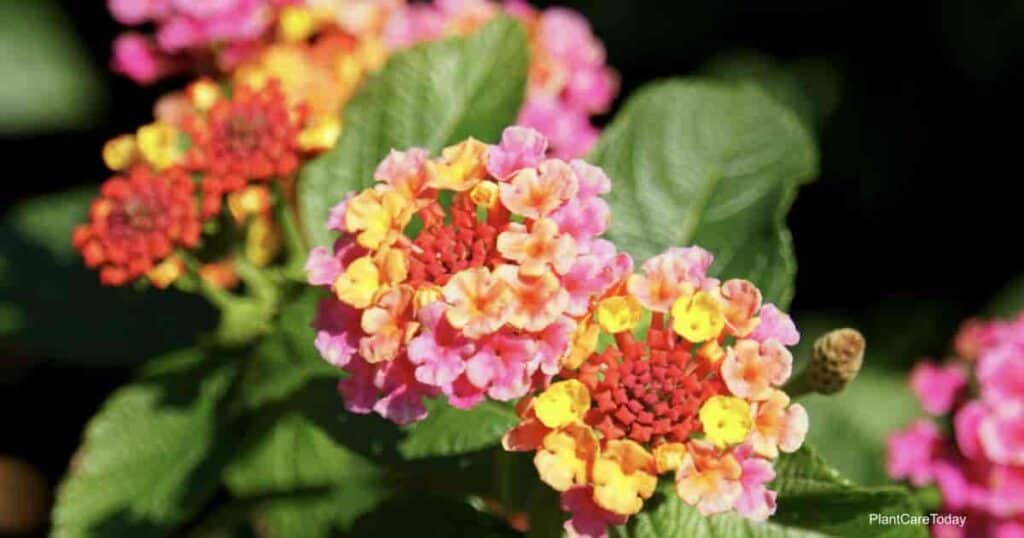
In grazing animals, Lantana-induced hepatotoxicity can cause high morbidity and mortality. Fatal poisoning has been reported in children ingesting green Lantana berries.
They are originally from tropical America but have spread through many of the tropical and subtropical locations of the world.
There are over 150 species of perennial flowering plants known as Lantana, a member of the Verbenaceae family of plants.
It has escaped gardens worldwide and is considered a noxious weed in many frost-free/tropical areas where it can rapidly spread to form dense thickets.
It has naturalized in parts of the southern United States, including southern Florida, the Gulf Coast, and southern California.
There is a great deal of hybridization among Lantana plants. This accounts for the fact that there are so many different cultivars and varieties.
Although Lantana is not technically verbena, they look very much like verbena.
Popular Lantana Articles:
Lantana Camara
Common Lantana or Lantana Camara has many cultivars. It is the most widely grown type of Lantana. These plants are usually quite large and may grow in a mounding habit, trailing, or spreading habit.

Lantana Camara grows 4′ feet tall and is winter hardy in USDA hardiness zones 8 to 12. It flowers in shades of:
- Orange
- Yellow
- Red
Lantana Camara is available in a vast number of varieties, including:
Athens Rose has a reasonably upright, mounding growth habit. This plant can grow to be about 3′ feet high. It produces magenta flower buds that open to become yellow and deep rose-pink blossoms.
Clear White is a low-spreading version of Lantana that produces all-white blooms.
Miss Huff is a very reliable, perennial Lantana that grows vigorously and quite tall. It has an upright, mounding growth habit and can attain a height of 6′ feet tall in a single season. Its flowers are mixed shades of gold, coral, and orange.
Mozelle is a sterile cultivar similar to Miss Huff in its hardiness and size, but its flowers are lighter pastel shades of pink and yellow.

Gold Mountain is a very hardy, vigorously spreading cultivar that attains a height of around 2′ feet. They spread to a width of approximately 4′ feet. These heavy-blooming cultivars produce deep gold flowers.
New Gold (Lantana camara x L. montevidensis) is a cross between Lantana Camara and Lantana montevidensis. It is very cold, hardy, and has medium yellow flowers. This plant grows about 16″ inches high with a spread of about 3′ feet.
Chapel Hill Gold is another low-growing, spreading Lantana cold hardy to USDA hardiness zone 7b. This plant produces golden-yellow blooms and grows about 1′ foot high with approximately 3′ feet spread.
New Red, Dallas Red, and Texas Flame are similar types of Lantana. All of these produce flowers in shades of crimson, orange, and yellow.
Patriot Cowboy is a smaller version of these, growing to a height of only 1′ foot.
Patriot Deen Day Smith is a new cultivar that produces flowers in shades of apricot, canary yellow, and rose pink. It is a vigorous grower with a mounding growth habit that attains a height and width of 5′ feet in a single season.

Patriot Desert Sunset is a sterile cultivar with an upright, mounding growth habit. It grows to a height of approximately 3′ feet with coral, pink, gold, and orange flowers.
Patriot Honeylove is a compact cultivar with a height and spread of about 2′ feet. Its flowers are pastel shades of ivory, yellow and pink. It has a slightly mounding growth habit and gently dangling limbs. It is a good choice for a hanging basket for tumbling over a wall.
Patriot Marc Cathey has a tall growth habit and bright, light yellow flowers. The centers of the flowers are a deeper, lemony shade of yellow. This vigorous grower attains a height of about 5′ feet.
Related: Growing Lantana in Containers
Patriot Popcorn is a sterile cultivar with a slightly weeping growth habit. It grows to be only about 1′ foot high with a spread of 2′ feet. Its flowers are a mixture of pale yellow and white.
Patriot Rainbow is a very small variety with a height of only 1′ foot and a spread of approximately 15″ inches. The plant produces many pale yellow flowers that transition into bright pink and orange.
Radiation is a very tall cultivar with an upright growth habit. It grows to a height and width of approximately 5′ feet with bright orange-red flowers.

Samantha has beautiful variegated foliage in shades of chartreuse and deep green. The flowers are a bright, lemony yellow. It is pretty similar to Lemon Swirl. These plants grow to 3′ feet high and spread approximately 4′ feet. This is a sterile cultivar that does not produce berries.
Silver Mountain has a spreading growth habit and produces pretty, creamy white flowers with gold centers.
Weeping Lantana has a vine-like growth habit. It grows to be 8″ to 12″ inches high with a spread of about 4′ feet as a groundcover.
This type of Lantana produces lavender-colored flowers and is a stunning choice trailing over the edges of a large planter or rambling over a wall. When crushed, the leaves are quite fragrant and produce a strange citrusy/gasoline scent.
Lantana Alba and Lantana White Lightning produce pure white flowers. Lavender swirl has white flowers that deepen in color to become pale lavender and eventually dark with age.
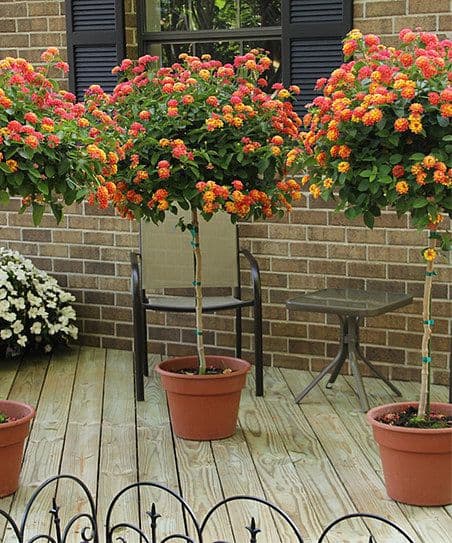
Lantana Horrida
Wild Lantana (Lantana horrida) can grow 6′ feet high. It is winter hardy in USDA hardiness zones 8 through 11.
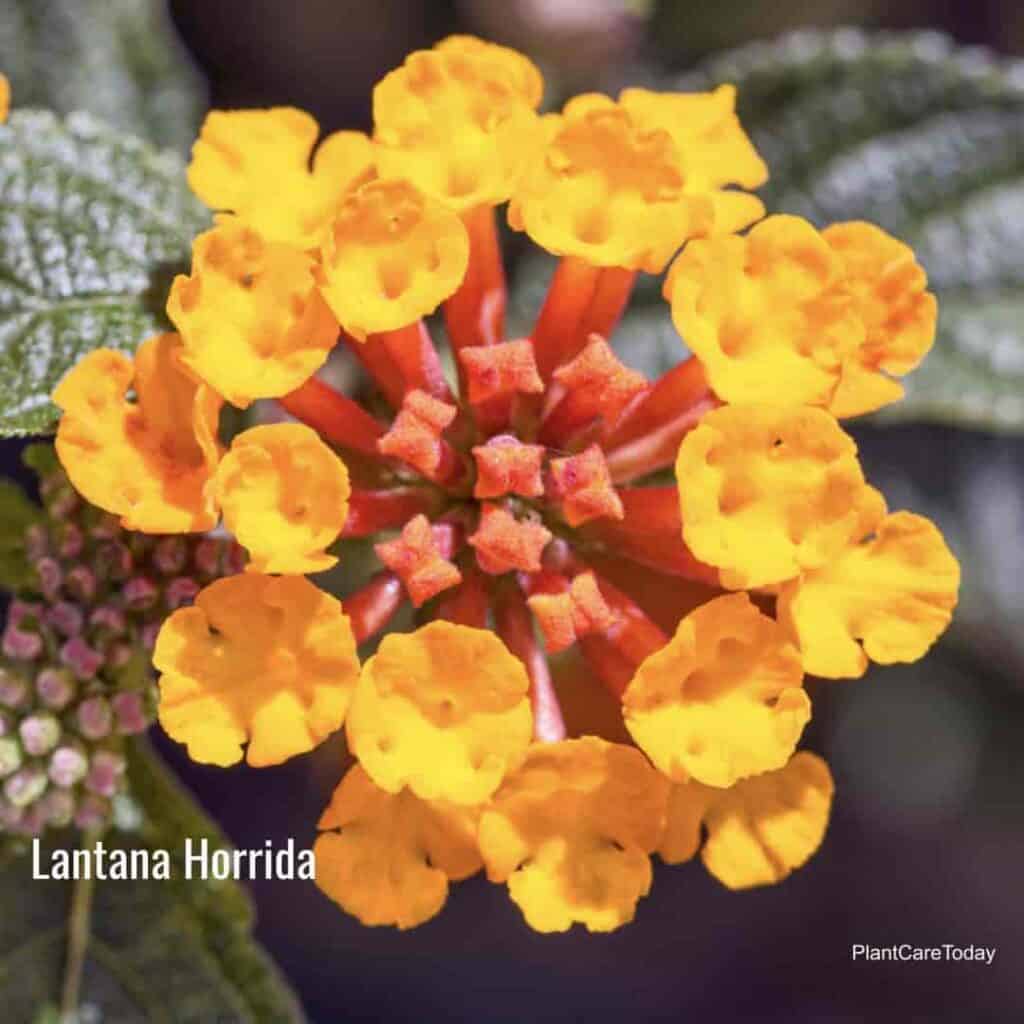
This wild plant likes full sun and produces abundant numbers of flowers in shades of:
- Orange
- Yellow
- Pink
- Red
This plant is native to South America and Mexico and grows naturally in various settings, including shrublands, grasslands, and mountainsides.
The plant grows as a mid-sized shrub and does best in sweltering climates. Its foliage is very strongly scented, and its flowers are beautiful to butterflies, bees, and hummingbirds. Its berries are juicy and plump and quite attractive to birds of all sorts.
Lantana Trifolia
Popcorn Lantana (Lantana trifolia) can grow to a height of 5′ feet and is winter hardy in USDA hardiness zones 10 through 11. Its flowers are pink or purple, and it produces very showy fruit.
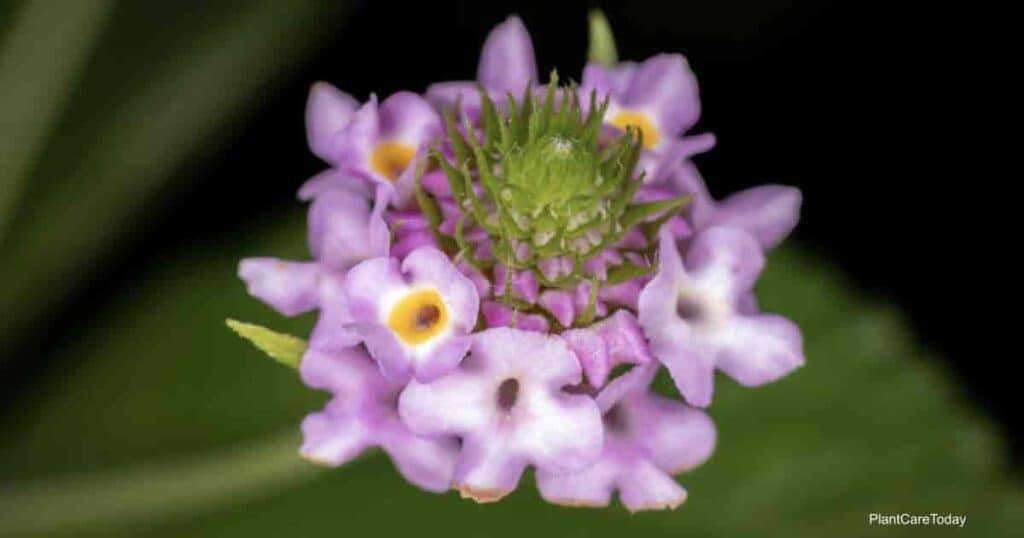
Popcorn Lantana is available in two varieties:
- Fruity Pebbles
- Lavender Popcorn
The berries of these cultivars grow in bright clusters. Fruity Pebbles grows pink, with juicy clusters of berries while Lavender Popcorn grows metallic, with lavender berries on stalks that look like small, metallic ears of corn.
These types of Lantana are perennial shrubs that do well in a wide variety of soil types and can be grown outdoors as perennial plants in conducive environments or taken outdoors in summer and during the winter in areas with colder winters.
Lantana Montevidensis
Trailing lantana (Lantana Montevidensis) can trail a distance of 10′ feet. It is winter hardy in USDA hardiness zones 8 through 11 and grows well in partial shade to full sun.
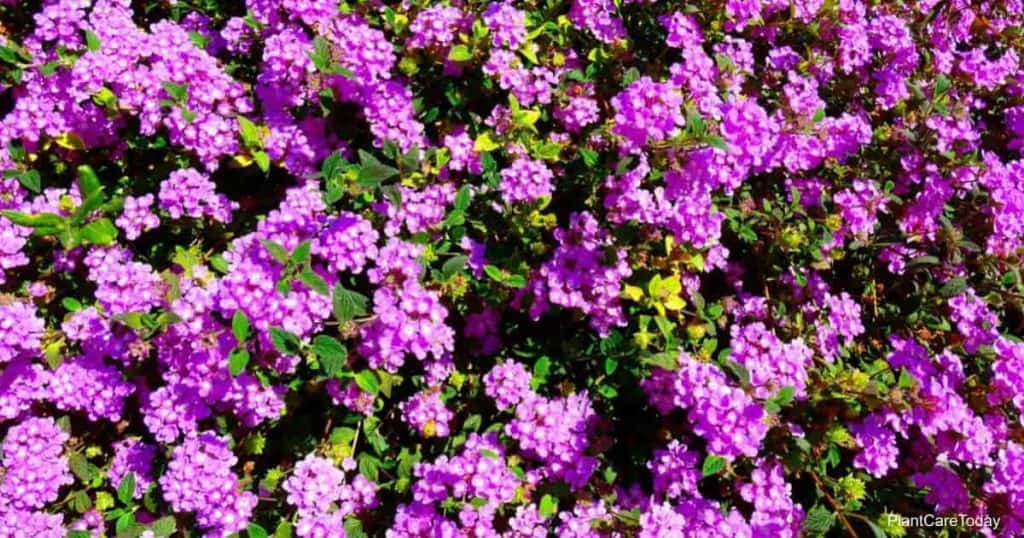
This ground cover produces flower colors in shades of white, yellow, and purple.
Varieties of trailing Lantana include:
- Weeping Lavender
- White Lightning
- Lavender Swirl
- Trailing Yellow Lantana
- New Gold
- Alba
Trailing lavender grows naturally throughout South America. It is an excellent choice for:
- Clambering over a fence
- Tumbling over a wall
- Hanging baskets
- Groundcover

This plant blooms from early spring through mid-autumn in cooler settings, but in its natural habitat, these trailing plants flower all year long in shades of lilac with yellow centers.
The plant has scented foliage that is deep green. Leaves are coarsely toothed and somewhat hairy. This type of Lantana is especially salt-tolerant and does well in beach settings.
Lantana Urticoides
Texas Lantana (Lantana urticoides) can grow to a height of 6′ feet tall. It is winter hardy in USDA hardiness zones 8 through 10 and likes a full sun setting.
Texas Lantana blooms in red, orange, and yellow shades and has an exceptionally long blooming season.
You may also hear this type of Lantana called Calico Bush. It can be difficult to tell it apart from wild Lantana; however, its location provides the most valuable clue. Lantana horrida grows naturally only in Mexico. Texas Lantana grows naturally in:
- Texas
- Arizona
- Louisiana
- Mississippi
- New Mexico
It usually grows in a woodland setting as a densely branching scrub. Texas Lantana is also unusual in that the older branches produce spikes.
The dark green leaves are richly scented and quite rough to the touch, and their sap can cause contact dermatitis.
Texas Lantana blooms early in the spring until late in the autumn. Individual blossoms are tubular in shape and transition into poisonous black berries.
Texas Lantana can grow 6′ feet tall. Regular pruning will keep its size under control. This variety does best in very hot, dry conditions.
Lantana Involucrata
Buttonsage (Lantana Involucrata) grows to a height of about 3′ feet and is winter hardy in USDA hardiness zones 9 through 11. This plant produces extremely fragrant white flowers. It does best in full sun and well-draining soil with very little moisture.
Buttonsage grows naturally in South America and also in Florida. However, this perennial plant grows well in coastal settings, where it blooms year-round.
The flowers are very fragrant, bright white with gold centers. The foliage has a sage-like scent when crushed. Therefore, you may also hear this plant referred to as Wild Sage.
This very bushy cultivar makes a lovely ornamental plant and also can be used exclusively as a hedge. This cultivar is extremely heat and drought-tolerant and does best in full sun.
Lantana Pastazensis
Lantana Pastazensis grows naturally in Ecuador. Unfortunately, this breed is endangered and red-listed as “vulnerable” in its conservation status.
It grows naturally in Ecuador’s tropical forests and thrives in high humidity. Unfortunately, you are unlikely to encounter this plant, and there is very little known about it. [source]

Common Pests
Lantana can survive most pests, but watch for the following insects that can cause problems if the infestation becomes severe. The four most common pests of lantana are aphids, lace bugs, mealybugs, whiteflies, and spider mites.
